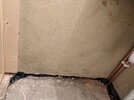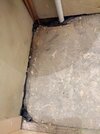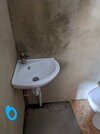We had this internal wall plastered several months ago. The wall is between our kitchen, which is being renovated, and a new bathroom under the stairs. Pipes have been laid under the bathroom floor for the sink and toilet.
The first circle and blob appeared shortly after the pipes were laid. The builder said hopefully they'd dry out. Several months later there are more (shown in attached photos). Our builder and plumber don't understand where the damp can be coming from as the pipes are just under the floor.
We want to get the wall painted soon, but don't want the plaster to crumble under the paint. I'm sure it will spread further.
Any ideas where it's coming from, and what do we need to do to resolve it? Thanks


The first circle and blob appeared shortly after the pipes were laid. The builder said hopefully they'd dry out. Several months later there are more (shown in attached photos). Our builder and plumber don't understand where the damp can be coming from as the pipes are just under the floor.
We want to get the wall painted soon, but don't want the plaster to crumble under the paint. I'm sure it will spread further.
Any ideas where it's coming from, and what do we need to do to resolve it? Thanks




